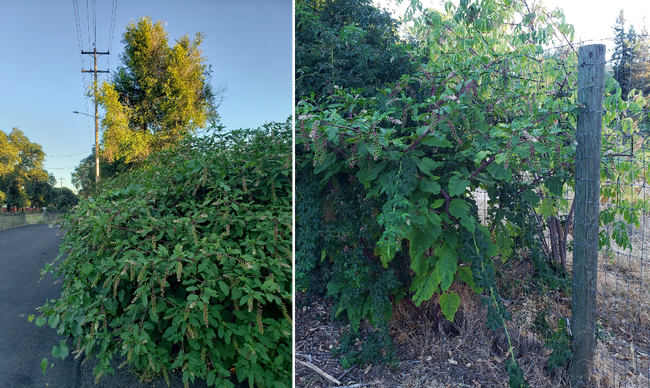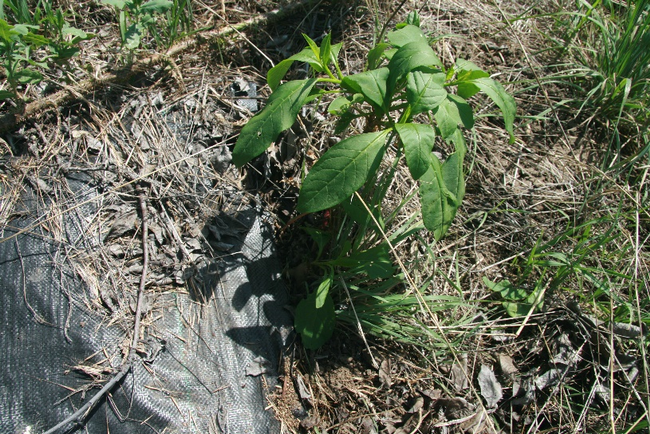In Northern California, Pokeweed (Phytolacca americana L.) has been around for a long time and is typically found in disturbed areas and fallow sites such as: under power lines, wooded areas, fences, pond edges, roadsides, etc. (Figure 1). However, in recent years, organic orchard growers throughout north coast have reported that pokeweed has been invading and contaminating new areas that were not found before.

Pokeweed is a perennial shrub whose shoot tissues die in the winter but exhibits rapid resprout from a large fleshy taproot in the growing season, causing panic among orchard growers. That kind of shrub can grow up to 10 feet tall, and a single plant can produce greater than 7,000 seeds annually. The seeds may survive in the soil for years before germination, and the new infestation occurrences are usually caused by seeds spread via birds.
Pokeweed contamination and management strategies in pear orchards floor have been the topic of discussion among growers, pest control advisers (PCAs), and farm advisors in the Lake County area. Growers typically monitor and control pokeweed in fallow sites to prevent seed production and spread. However, due to the lack of training or an efficient management program, the control is not always carried out timely and adequately, and seeds end up escaping and contaminating new areas.
In organic pear orchards, pokeweed management is difficult due to the limited number of strategies available. Mowing or hand-pulling has been the primary management strategy in organic areas. Young plants may be removed easily by hand at the beginning of the growing season. However, due to the robust taproot system, once established, plants will produce regrowth quickly from mowing, and hand pulling is laborious.
Tarps or fabrics have been used by growers to suppress pokeweed as well; however, once the weed is already established, pokeweed has shown a strong capability to overcome and regrow from those strategies (Figure 2).

The growers have also tried to adopt non-synthetic herbicide products for pokeweed control. Among those available commercial products, the active ingredients, including acetic acid, citric acid, caprylic acid, capric acid, pelargonic acid, Clove oil D-limonene, and others, have been used for the non-selective control of that weed.
Usually, organic herbicides are recommended for weeds in the early stages of growth. For pokeweed already established, organic herbicides have shown poor effectiveness, and growers have reported that pokeweed begins recovery approximately two weeks after treatment application (Figure 3). Preliminary studies have shown that organic herbicides applied to control weeds may require late sequential application due to the non-systemic characteristics of these products.

Where do we go from here?
UC Cooperative Extension - Diversified Agricultural System program, in collaboration with UC IPM, UC Davis experts, and the Pear Advisory Board, has been designed and will conduct field trials during the 2023 and 2024 growing seasons to access long-lasting control of pokeweed in organic orchards using different organic management strategies including mechanical weeding and use of non-systemic herbicides. The primary objective of those trials is to provide California orchard growers and agricultural PCAs with an organic weed management program for long-lasting control of pokeweed on orchards floor.
Attached Files: